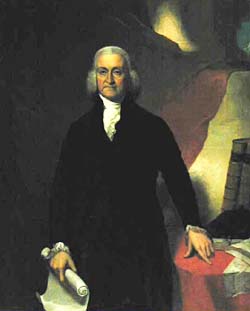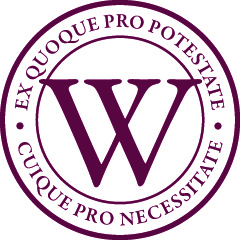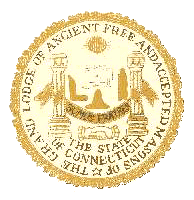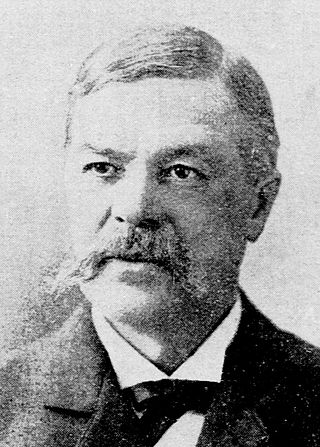
Theodore Sedgwick was an American attorney, politician, and jurist who served in elected state government and as a delegate to the Continental Congress, a U.S. representative, and a senator from Massachusetts. He served as President pro tempore of the United States Senate from June to December 1798. He also served as the fourth speaker of the United States House of Representatives. He was appointed to the Massachusetts Supreme Judicial Court in 1802 and served there for the rest of his life.

Jonathan Trumbull Sr. was an American politician and statesman who served as Governor of Connecticut during the American Revolution. Trumbull and Nicholas Cooke of Rhode Island were the only men to serve as governor of both a British colony and an American state, and he was the only governor to take up the Patriot cause at the start of the Revolutionary War. Trumbull College at Yale University, the town of Trumbull, Connecticut, Trumbull County, Ohio, and Jonathan the Husky are all named for him.

Grove Street Cemetery or Grove Street Burial Ground is a cemetery in New Haven, Connecticut, that is surrounded by the Yale University campus. It was organized in 1796 as the New Haven Burying Ground and incorporated in October 1797 to replace the crowded burial ground on the New Haven Green. The first private, nonprofit cemetery in the world, it was one of the earliest burial grounds to have a planned layout, with plots permanently owned by individual families, a structured arrangement of ornamental plantings, and paved and named streets and avenues. By introducing ideas like permanent memorials and the sanctity of the deceased body, the cemetery became "a real turning point... a whole redefinition of how people viewed death and dying", according to historian Peter Dobkin Hall. Many notable Yale and New Haven luminaries are buried in the Grove Street Cemetery, including 14 Yale presidents; nevertheless, it was not restricted to members of the upper class, and was open to all.

Wooster School is a private, co-educational, college-preparatory school in Danbury, Connecticut. It is a member of the Connecticut Association of Independent Schools.

David Wooster was an American general who served in the French and Indian War and in the American Revolutionary War. He died of wounds sustained during the Battle of Ridgefield, Connecticut. Several cities, schools, and public places were named after him thereafter. He has been called "a largely forgotten hero of the Revolution."

Marshal Jean-Baptiste Donatien de Vimeur, comte de Rochambeau was a French nobleman and general whose army played a critical role in helping the United States defeat the British Army at Yorktown in 1781 during the American Revolutionary War. He was commander-in-chief of the French expeditionary force sent by France to help the American Continental Army fight against British forces.

Stephen Row Bradley was an American lawyer, judge and politician. He served as a United States Senator from the state of Vermont and as the President pro tempore of the United States Senate during the early 1800s.

The Connecticut Line was a formation within the Continental Army. The term "Connecticut Line" referred to the quota of numbered infantry regiments assigned to Connecticut at various times by the Continental Congress, the size of its allocation determined by the size of its population relative to that of other states. These, together with similarly apportioned contingents from the other twelve states, formed the Continental Line. The concept was particularly important in relation to the promotion of commissioned officers. Officers of the Continental Army below the rank of brigadier general were ordinarily ineligible for promotion except in the line of their own state.
The 1st Connecticut Regiment (1775) was raised on 27 April 1775 at Norwich, Connecticut in the Connecticut State Troops. The regiment consisted of ten companies of volunteers from New Haven and Litchfield counties of the state of Connecticut.

The Grand Lodge of Ancient Free & Accepted Masons of the State of Connecticut is the main governing body of Freemasonry in the U.S. state of Connecticut as recognized by the United Grand Lodge of England. The Grand Lodge of Connecticut is headquartered at Wallingford, Connecticut.
Gold Selleck Silliman (1732–1790) was a Connecticut militia General during the American War for Independence.
The Battle of Ridgefield was a series of American Revolutionary War skirmishes in Danbury, Connecticut and Ridgefield, Connecticut.

The New Haven Collegiate and Commercial Institute was founded by Stiles French in 1834 and is a defunct military academy and college preparatory school that "fitted" students to apply for entrance to nearby Yale or West Point, as well as offering classes in business skills like book-keeping. The school was located at Wooster Square in New Haven, Connecticut, USA, about a mile from the Yale campus.

David Torrance was a soldier, lawyer, politician, and chief justice of the Supreme Court in Connecticut.

Araucano was a 16- or 18-gun brigantine of the First Chilean Navy Squadron.

Aquiles was a brigantine, originally Spanish, that later served in the Chilean Navy. Sunk off Valparaíso on 24 July 1839.

Wooster and Davis -- Lieutenant Stanton Hall Wooster and Lieutenant Commander Noel Guy Davis were two United States Navy (USN) airmen who made an attempt to fly the Atlantic Ocean from New York to Paris in the spring of 1927. The men were trying to win the $25,000 Orteig Prize offered by New York hotelier Raymond Orteig for the first nonstop flight between New York and Paris. Competitors for the prize were French World War One ace Rene Fonck and his crew of three, USN Commander Richard Evelyn Byrd, Clarence Chamberlain with plane owner Charles Levine, and a young airmail pilot named Charles Lindbergh. On the Paris side of the Atlantic their competitors were another World War One French ace, Charles Nungesser, and his navigator Francois Coli.

Provincial troops were military units raised by colonial governors and legislatures in British North America for extended operations during the French and Indian Wars. The provincial troops differed from the militia, in that they were a full-time military organization conducting extended operations. They differed from the regular British Army in that they were recruited only for one campaign season at the time. These forces were often recruited through a quota system applied to the militia. Officers were appointed by the provincial governments. During the eighteenth century militia service was increasingly seen as a prerogative of the social and economic well-established, while provincial troops came to be recruited from different and less deep-rooted members of the community.
Whiting is a given name. Notable people with the name include:















